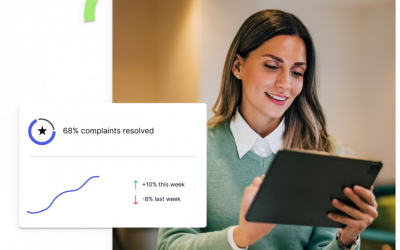Whenever we have conversations with our customers or business leaders in the HR space, we are asked a lot of great questions. This blog contains our answers to the questions we are asked the most often. We hope our responses will inform, encourage, and empower you and your teams. Let’s dive in!
1. How is AI changing the way businesses view people analytics?
With AI fast becoming a keystone part of the business world, organizations are better equipped to leverage vast amounts of data within their operations. This is shifting the perception of people analytics to a strategic driver of organizational success.
A major way it’s doing that is through the capacity to consume and analyze more data faster and with greater accuracy than we humans could ever do on our own. Teams can then use that data to see patterns that may have been missed without AI, create accurate business projections, and make informed business decisions.
Large Language Models
At ZeroedIn, we’ve been working to integrate Large Language Modeling (think ChatGPT) into our solutions. When it’s live later this year, this integration will allow customers to ask questions of their data and receive responses written in narrative form. You’ll be able to ask ZeroedIn’s generative AI engine to analyze your data and explain (for example), where gaps exist in your current business strategies, which months are most productive for which departments, which managers have the most agile teams, where you may have pay gaps, and even how DEIB initiatives in your business are impacting hiring practices.
Where we differ from ChatGPT, though, is in the search size. ChatGPT searches the entire web for answers, while ZeroedIn’s AI will focus on each client’s unique and secure internal data to analyze topics like your company’s critical needs and gaps in your L&D, DEIB, and talent acquisition metrics.
Automating insights to your workforce analytics dashboard
AI capabilities are a streamlined solution for automating insights to your workforce analytics dashboard. Instead of having to click between multiple pages and models, you can ask the AI to analyze that data and draw a conclusion based on what it sees. You’ll then receive a natural language response of what the AI noticed that you can use to make decisions moving forward. In the end, AI is a very useful tool in completing repetitive tasks, complex evaluations or forward looking projections and scenarios with speed. This will allow the human workforce to focus on interpretation, decision-making and implementing change. It is the combination of AI and people that truly makes the difference.
2. How do you leverage workforce analytics software like ZeroedIn for effective workforce planning?
When leveraging workforce analytics software for your workforce planning, it’s important to identify what’s needed for you to maintain business. This means determining whether you have the right number of people in the right places within your organization and whether the roles you’ve already hired for have the right people.
The only way to do that is with insights from throughout your organization, including your HR systems, performance management tools, and time tracking systems. From there, you can use historical data and external factors, such as industry trends and economic forecasts, to estimate future workforce demand and supply. This helps in anticipating talent shortages, identifying critical roles, and developing appropriate hiring and retention strategies.
ZeroedIn helps you map out your data and draw accurate conclusions with its fully integrated people analytics dashboard. With our tool, you can leverage accurate, complete, and up-to-date data from across your organization to determine skill gaps and development opportunities, anticipate talent shortages, and identify high-performing talent. You can also examine current EOY metrics, develop forecasting for the next year, and even monitor your company’s actual changes over time compared to that forecast. This way, there are fewer surprises and you can address potential issues before they become a reality.
3. What insights can be gleaned from comparing internal people data with external benchmarking and/or market data?
Imagine you’re a mid-sized clothing retail company with 35 locations in the Midwest and you seek to expand into the West Coast. Before you do, it’s a good idea to examine the existing market in the area and the stores you’ll be competing against (local and franchised clothing stores with established bases on the West Coast). Doing this can give you valuable insights into what your target market (each new city) expects from companies in that area, and it can help you position your new location as a business to buy from and work for. These data points include other companies’ pay rates, their retention rates, where they’re finding their workforce, which roles fill quickly, and which receive the fewest applicants. Some of this data may be available publicly, while others may need to be purchased or gathered through studies. All of this information is important to make decisions regarding each new location’s pre-open planning.
Now let’s apply that thought process to your own business.
Making data-driven decisions
Regardless of whether your company’s industry is finance, retail, medical, government, or in another field, gathering external benchmarking and market data has ample benefits, including an increased ability to create targets and goals that set your company apart from competitors as the optimal choice. To put it simply, the best business decisions aren’t made in a vacuum. Instead, they’re made by comparing your business to others according to geography, industry, etc. and assessing them in conjunction with internal goals, benchmarks, historical data, and, of course, current people data. Comparing your data to others helps you gain insights into your target market as you expand, after you’ve expanded, and even before you expand; it helps you set targets based on what others are trying to do and accomplish. And, since you understand how competitors are positioned, you can determine whether to follow the same strategies, improve upon those strategies, push off into an entirely new direction, or even all three at once.
This external data doesn’t have to be competition-based. Companies like Safelite AutoGlass, for example, are interested in analyzing external data like weather patterns against employee time and attendance. If they have a hypothesis that inclement weather increases callouts and absenteeism, having access to employee data via workforce analytics software enables them to compare and correlate the two to prove or disprove that assumption.
4. What does it look like to build a talent marketplace and what value does it bring?
A talent marketplace can be strictly internal, strictly external, or a combination of both. Regardless of which you opt to build with your business, many of the base functions remain the same. With a talent marketplace, businesses can tie skills to both people and jobs. This makes it easier to determine who the best hires are, what skills are required for each role within the organization, and which training programs or certifications are necessary for success within each role. We see many businesses build an internal marketplace first, then expand into the broader external workforce as they get their systems up and running.
Internal Facing
When you build an internal talent marketplace, the goal is typically to improve lateral movement and growth within the organization, provide greater flexibility for assigning individuals to specific roles, and offer a greater variety of experiences (think “gig economy”). It involves tying skills to both existing employees and to roles within your company and often results in better employee engagement, more opportunities for growth, and greater employee ownership of their career paths. With this tie, employees can assess their skill set and compare it with the skills required for the roles they aspire to pursue. From there, employees can work to level up their skill sets through learning and development programs the company offers, through coursework from colleges, universities, and outside training programs, or through personal reading and research.
Company management can also use this marketplace to inform promotions, structural reorganizations, and programs geared toward learning and development. And if you combine marketplace data with flight risk or retention data, it can also help management determine the propensity of employees with certain skill sets or in specific roles to leave an organization before their leaving becomes a reality.
Take the City of Detroit, for instance. Since working with ZeroedIn, they’ve cleaned and combined more than 60 million lines of historical and current people data as the City looks ahead to the development of a Talent Marketplace solution that helps them better understand the careers of more than 9,000 employees. This includes HRIS, payroll, time and attendance, recruitment, talent management systems, City budget, and position-related data, all of which is displayed and analyzed in their custom-built people analytics dashboard. With much of their existing data in the ZeroedIn platform, we are well positioned to offer the City of Detroit data-driven insights and forecasting capabilities that fit their business and budgeting needs.
External Facing
The difference between an external marketplace and an internal one lies in the group that has access. Instead of it being your current employees who can see the skills tied to existing roles, it’s your prospects. With this model, prospective employees can self-identify the skills they have and use them to determine which roles in your organization best fit those skills.
On the management side, this external view remains mostly identical to the internal one, with a few changes and updates. Instead of using it to examine tenure, growth opportunities, and pay gaps, you can use it to gather data on application rates for certain positions, common skill sets that exist or are missing from applications, and even the demographics of applicants across position types and titles. Having an external marketplace can also create potential for developing teams of fractional resources that can work together project-by-project or longer-term, based on the skills needed to get work done.
5. What is the biggest difference between ZeroedIn and competitors like Crunchr and Visier?
Although ZeroedIn, Crunch, and Visier are sometimes all referred to as people analytics, workforce analytics, and business intelligence tools focused on the HR industry, we have some key differences. Here’s some of what sets ZeroedIn apart from competitors.
Combining your entire HR ecosystem into a single source of truth
Our comprehensive platform was created to make people analytics easier for your business. We do it through integrations with your entire organization, allowing you to aggregate and analyze data from multiple systems in one central platform. This provides easy accessibility to workforce data for analysis and reporting. We also offer features like data integration, metrics tracking, predictive modeling, and scenario planning, with a strong emphasis on workforce planning and development.
Flexible data model
If you need it, we can analyze it. Most data models are built from scratch or are inflexible and cemented by the software developer. In contrast, ZeroedIn comes with a robust data model built using more than 20 years of experience and innovation (this is our secret sauce!), and our model allows for customers to provide input and add additional fields and calculations to the data based on their own unique business operations and requirements. On demand configuration is an inherent property of the model so that we can manage and scale the solution over time, meaning we are neither a one-size-fits-all solution nor an open architecture that places the full burden on your team to build, maintain, and update it over time.
And if you aren’t sure which data you need and which answers you’re looking for, we can help with that too. For example, we can take our data model and alter it based on your unique business needs, adjusting over time as needed. This includes unique calculations for things like flight risk and compensation modeling, as well as analysis of salary positions compared to others in the same industry or geography using external data sources. All of this can be viewed in the same drillable dashboard view.
White Glove Customer service
Just like data needs regular analysis, our customers deserve (and receive!) regular check-ins with our team.
There is no “impossible to contact” client service team here. Instead, we offer white glove service to every customer and will meet with you to support changes and updates to your data, reports, and dashboard as business needs evolve. This might include enabling you to see HR and business data together like we did for Williams Sonoma or even empowering you to clean and combine historical and current data for workforce decisions like we did with the City of Detroit. You can make these changes on your own time, have us do it for you, or work with our team to make them together, depending on your availability and needs.
Streamline workforce insights with integrated surveys
ZeroedIn’s survey tool isn’t just collecting and consuming data, only to spit it back out. This tool can be used to combine anecdotal and measurement data in a single source. Survey options include new hire surveys, exit surveys, performance surveys, 360 performance surveys, and anything else you might need.
With this tool, you’ll no longer have to experience delays in interdepartmental communication. Let’s say, for example, your business is in the medical field and patient readmittance rates have dropped. Instead of having to manually reach out to each department to determine how readmittance rates have affected them or noticing this trend months after the fact (when insights won’t be as accurate), an automated survey can be triggered as soon as rates begin to decline. From there, it can be sent out to managers or other members of the affected departments to respond. Their feedback can move the conversation surrounding readmittance rates forward and inform decisions on how to address it.
And with ZeroedIn, all of that information (readmittance rates and feedback) can be shown in one dashboard, along with a response from our large language modeling tool analyzing the data to determine potential reasons behind the drop, help you better understand what happened and whether there was an issue, and empower you to address that issue if there is one.
Multi-Source Dashboard
A final key difference between ZeroedIn and our competitors is our dashboard, which shows data across multiple sources that’s ready for discovery and drill-down. We alleviate the difficulty not having a single view can have and enable you to fully understand and act upon your company’s data without a struggle.
What Did We Miss?
These are the main questions we frequently hear from clients and HR leaders. What other questions do you have? We’d love to hear from you on LinkedIn or let’s schedule a time to chat directly.




